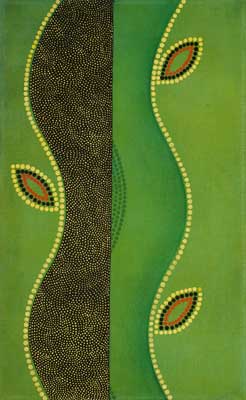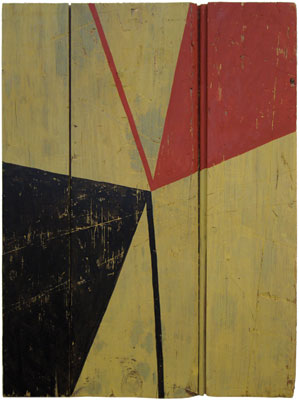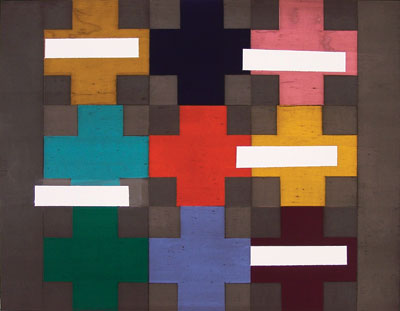The Language of Abstraction
THE CANVAS-June 2009
by Suzette McAvoy
Joshua Ferry, Mark Wethli & Grace DeGennaro
Abstraction allows man to see with his mind what he cannot physically see with his eyes…to perceive beyond the tangible, to extract the infinite out of the finite. -Arshile Gorky

Sensual Geometry
Grace DeGennaro employs traditional symbols and the universal language of geometry to create luminous paintings that are timeless in their message and visual resonance. Working from her studio in the old Cabot Mill at Fort Andross in Brunswick, she describes her practice as “an intuitive one of identifying and depicting images that are both iconic and numinous.” Rivers, vines, diamonds, fountains, cubes, the vesica piscis (an elliptical shape formed by the intersection of two circles), and the phases of the moon are all symbols that appear in her recent work.
Green River is one of a series of paintings shown last year at Aucocisco Gallery in Portland. It exemplifies her nonlinear, abstract approach to image making and her sensuous approach to geometry. “Many of my recurrent geometric forms suggest the body,” she says. “In Green River…the river and vine shapes curve like torsos.” As in many of her works, the central curving form extends beyond the limits of the composition, implying a sense of borderless infinity. For the artist, the river’s movement suggests the dualities of “the spiritual and the earthly, heaven and hell, north and south.”
DeGennaro is an adventurous colorist, and her work embraces a wide range of intense, sophisticated hues. She begins each painting by applying many successive layers of transparent color to build up an inviolable ground. The image is then added through a “deliberate accretion of dots and beads of color” that are painted by hand using small brushes. This labor-intensive method both supports and reflects the themes of ritual, growth, and the passage of time that are central to her art.
Committed to a vocabulary of abstraction, and drawing on sources of inspiration as diverse as Navajo blankets, aboriginal art, Byzantine mosaics, Egyptian hieroglyphs, Indian Tantra drawings, fairy tales, and Shaker art, Grace DeGennaro’s work speaks an inner, spiritual language that can be understood by all.
Grace DeGennaro lives in Yarmouth and is represented by Aucocisco Gallery in Portland and Clark Gallery in Lincoln, Massachusetts. She graduated from Skidmore College in 1978 and received a master of fine arts degree from Columbia University in 1986. From 1998 to 2002, she was a studio instructor in the graduate studies programs at Maine College of Art. Her works have been shown throughout Maine, New York, and Massachusetts.
Green River, 2007, oil on linen, 26” x 16”
 Distilling Memory and Time
Distilling Memory and Time
Nine years ago, artist Mark Wethli traveled throughout Spain, including the island of Mallorca. Memories of that trip, especially of the muted wall colors and worn surfaces abraded by weather and time, sprang to mind when he embarked on his latest series of works. Painted on recycled wooden table tops, this new group of paintings marks a change of approach for Wethli, who recently has worked with vivid colors composed in grids or lines, as in the large wall piece, Transom, that animates the lobby of the Portland Museum of Art.
The first major shift in Wethli’s art occurred in 1999, just before his trip to Spain, when after years of painting exquisite representational interiors, he found himself in need of a new challenge. “The surprise was no longer there,” he says. The result was the move to geometric abstraction and the abandonment of his previous style. But for Wethli, the change felt natural. “I simply took away representation, revealing another part of the work that for me had always been there.”
Balance, shape, and harmony are essential elements that run throughout Wethli’s work. In his new paintings, the vertical lines and grooves of the found table tops provide the compositional scale for Wethli’s painted shapes, which either radiate out from the center, as in Mallorca, or take the form of L-shapes based on grid-pattern variations. Thinly painted, the works have an intentional “hand-hewn” look and an endearing insouciance. “I wanted to foreground the texture of the board: I didn’t want the paint to bury that,” says the artist. “I wanted the board’s history to show.”
Inspired by such wide-ranging sources as the abandoned windmills of Spain, the hand-painted signs of rural Maine, ethnographic objects from Africa and Oceania, and the still-life painting of Italy—not to mention his personal experience—Mark Wethli’s lastest work transforms the prosaic into the poetic.
Mark Wethli lives and works in Brunswick, where he is the A. LeRoy Greason Professor of Art at Bowdoin College. His work is in the collections of the Metropolitan Museum of Art, the Farnsworth Museum of Art, and the Portland Museum of Art, among others. His work is shown at RedFlagg Gallery in New York City, Whitney Artworks in Portland, and Icon in Brunswick.
Mallorca, 2009, acrylic on found wood panel, 20” x 15”
 Painting as Discovery
Painting as Discovery
Making use of words, maps, flags, and found Internet photos, Joshua Ferry makes paintings that are occasionally political, often colorful, and always graphically bold. Constructed from many layers of applied and sanded paint, the surfaces of his works are as complex as his imagery is simple and direct.
For three years after graduating from Maine College of Art in 1994, Ferry worked as a woodworker and furniture finisher at Windsor Chairmakers in Lincolnville. “Sanding,” he says, “became an important part of my painting process which continues to this day.” This attention to surface texture and his affinity for abstract work can be traced to his studies at MECA with Johnnie Winona Ross and James Cambronne, two of Maine’s most distinguished abstractionists. “My best paintings force me to embark on an investigative journey rather than simply depict an idea,” says Ferry. “Ultimately I like to be surprised by my work.”
A case in point is Pros and Cons, a mixed-media work from 2007 that began as a grid of gray squares from which the colored cross shapes emerged during the painting process, suggesting to the artist an altar cloth or religious banner. He also interpreted the crosses as plus signs, and his reaction was to paint negative or minus signs over them “to balance the situation.”
Joshua Ferry’s paintings first drew statewide attention in 2005 when two of his works were included in the Portland Museum of Art’s biennial exhibition. The following year, he received honorable mention for his submissions to the biennial show at the Center for Maine Contemporary Art in Rockport—a distinction he received again in 2008. Ferry’s talent has also drawn praise from established painters such as Sam Cady and Katherine Bradford, while art collector Sam Mitchell, another fan, already owns several major pieces. Clearly, Ferry is a younger-generation artist to watch.
Originally from New Hampshire, Joshua Ferry moved to Augusta at age 15 and graduated from Cony High School in 1990. He attended Maine College of Art and received his master of fine arts degree from Rutgers University in 1999. Today, he lives in New Jersey and spends vacations and summers in Maine. His work can be seen at www.joshuaferry.com.
Pros and Cons, 2007, oil, acrylic, alkyd resin, and wax on canvas, 12” x 20”